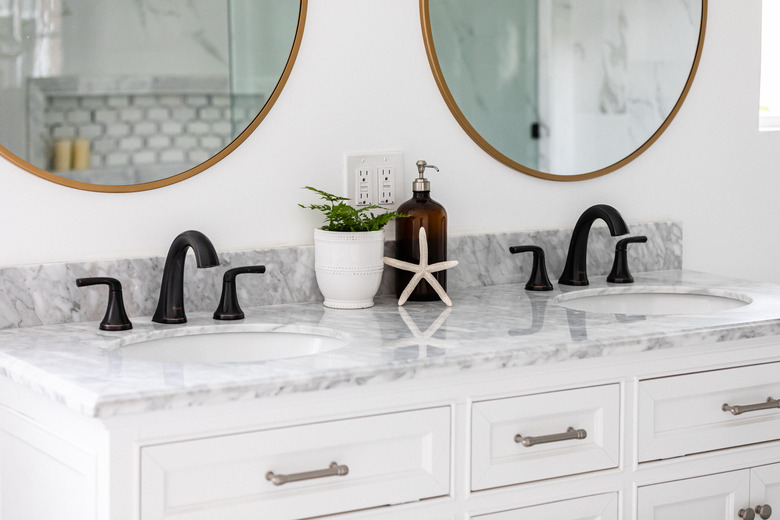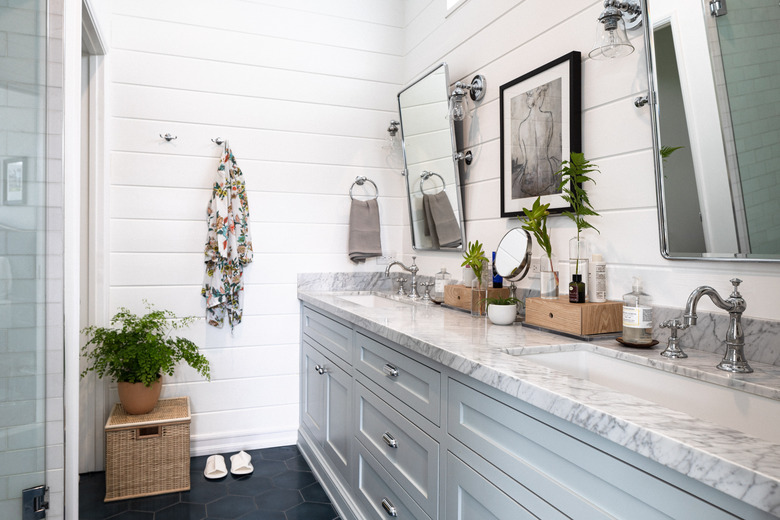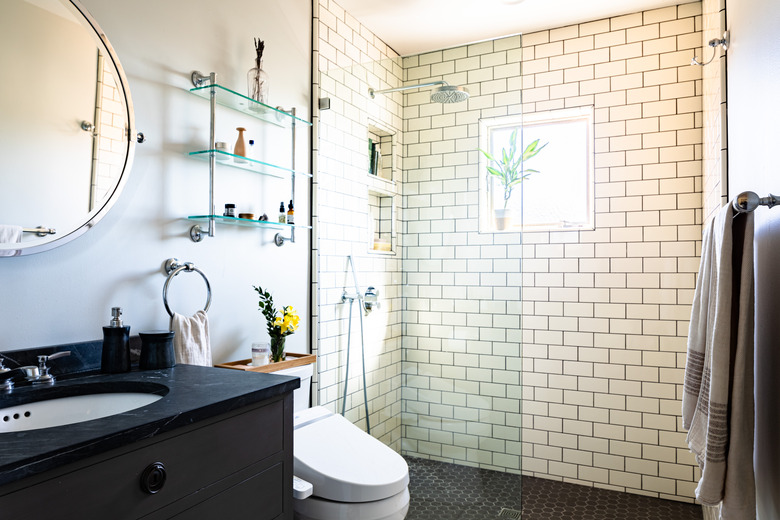Why And How To Choose A Bathroom Vanity With An Undermount Sink
When shopping for a new bathroom vanity, you have a lot of choices to make. You need to decide on the size (and, if the available vanity area is large enough, whether you want one or two sinks); the faucet style; whether you want a backsplash and/or sidesplash; the materials of the cabinet, sink, vanity top, faucet and backsplash/sidesplash; and whether you want a pedestal, wall-mount, drop-in, vessel or undermount sink. In fact, one of the most important decisions will be the sink type.
There are many benefits to getting an undermount sink, but these should be carefully weighed against the advantages of a drop-in sink, vessel sink or integrated sink so you can be sure you purchase the right option for your needs.
Benefits of an Undermount Sink
One of the greatest benefits of an undermount sink is that it is very easy to clean since the counters can simply be wiped right into the sink. In fact, the only sink type that is easier to clean is the integrated sink, in which the counter and sink are made from one solid piece, leaving them without a joint between the sink and vanity top at all. Similarly, an undermount sink vanity will often look more streamlined because it does not have a drop-in or vessel sink interrupting the counter, though an integrated sink will look even more sleek since there is no disconnect between the sink and vanity top at all.
While many people choose to purchase their undermount bathroom sinks preassembled with their vanity top, you can also choose to buy them separately, allowing you to get exactly the perfect vanity top/bathroom sink combination. On the downside, the installation of an undermount sink can be challenging because you have to glue the sink to the underside of the countertop, providing temporary support and getting the fit just right before the adhesive sets. If this is something you don't want to tackle yourself, you can choose a vanity with a preinstalled sink or hire a pro to handle the job.
Undermount sinks are incredibly popular. In fact, Remodeling states that the National Kitchen and Bath Association's trend report indicates 87 percent of bathroom sinks are undermounts. That popularity can be a good or bad thing depending on your personal preferences. If you're looking for something that will really stand out, you might prefer something less common, like a vessel sink, but you can also opt for a more eye-catching material, such as glass or copper.
An important consideration with undermount sinks is the countertop material. Undermounts work with solid surface, natural and engineered stone, cultured marble and solid wood, but not with with laminate or tile countertops. Because the hole for the sink is exposed, the countertop material must provide a clean, smooth, water-resistant edge, and this is difficult to achieve with laminate and tile.
Matching Undermount Sink and Vanity Top Materials
The vast majority of undermount sinks are vitreous china, fireclay or porcelain, which are all varieties of ceramic that have a sleek, waterproof surface. While you can find a ceramic sink in other colors, most buyers stick with white, which can match just about any vanity top material, including natural stone, solid surface, quartz, cultured marble and more. Whether you go with a vitreous china, fireclay or porcelain sink, expect it to be easy to clean, durable and resistant to bacteria and stains.
While the majority of homeowners stick with a ceramic sink, you can find undermount sinks in a wide array of materials to suit any vanity and overall bathroom decor theme. A few popular options include:
- Cast iron: One of
the most popular options aside from ceramic sinks, cast iron sinks are made
from iron and are coated with the same enamel used on vitreous china. They come in
a wide array of colors and are easy to clean, but Ferguson Enterprises warns that the enamel can be chipped if hit with a heavy object
(like something that falls from a medicine cabinet), and this can eventually
result in rusting if not repaired. Like a ceramic sink, cast iron sink works with
most vanity top materials, but because it is a bit heavy, it does particularly
well with something sturdy, like quartz, granite, or marble. - Glass: Made
from high-quality, tempered glass that offers excellent strength and durability,
glass sinks come in a wide array of patterns and colors that offer a truly
dramatic appearance. On the downside, the more eye-catching your sink, the more
difficult it can be to match with a vanity counter top without having a
bathroom vanity design that looks too busy. For this reason, neutral-toned,
solid-surface counters are often the best choice to complement your sink. It's
also worth noting that tempered glass can still chip more easily than other
materials, and it is prone to water spotting. - Metal: While
more commonly used in kitchen sinks, metal sinks are being used with increasing
frequency in the bathroom vanity. Some of the most common metals used in vanity
sinks include stainless steel, copper and brass. Stainless
steel is easy to clean, but brass and copper may require special cleaning products, though brass and copper are naturally anti-microbial. These sinks
look great with stone counters, especially quartz or granite,
though they can also look nice with a solid surface or tile as well. Keep in
mind that most metals should be wiped after use to avoid water stains and that
some metals are prone to developing a patina that may change their original
color. - Solid surface: Made
from the same durable material as solid-surface countertops, these sinks come
in a wide array of colors and patterns and may even be made to look like stone,
such as granite. They are easy to clean and can be repaired if they become scratched. While they can be matched to most countertop materials, many people
choose to pair solid-surface sinks with vanity tops made from the same material.
Undermount Sink Buying Considerations
There is no standard sink size when it comes to undermount sinks, so if you're not buying a preassembled sink/vanity top combination, you'll need to make sure your counter and sink work together. These sinks may come in rectangular, square, oval or circular shapes. You can always have a vanity top custom cut for your sink, but if you don't want to pay for custom work, be sure you buy a sink that exactly matches the size and shape of the sink hole in your vanity or vice versa. This is particularly important if you want to keep your old bathroom vanity top and just replace the sink.
Another thing for which to look is the number of faucet holes in the sink. Some undermount sinks are designed for the faucets to be installed externally in the counter or wall, but others have an area where the faucet will be installed onto the sink itself. If you want a sink-mounted faucet and have a particular faucet style in mind, be sure to choose a sink with the correct number of holes. In other words, if you want a single-hole faucet, buy a sink with one faucet hole, but if you want a three-hole faucet, get one with three holes.
Maintaining a Vanity With an Undermount Sink
While cleaning a vanity top with an undermount sink is fairly simple because you can just wipe down the bathroom fixtures and then wipe the counters into the sink, the joint connecting the sink to the vanity top may occasionally need some special attention since it can get grimy or moldy. Getting the joints clean can be difficult, as the cleanser may drip from the joint into the sink. Checking in With Chelsea suggests cleaning these joints with a paste made from bleach and baking soda. Apply the paste with a paintbrush and then seal it in place with plastic wrap to prevent the bleach from evaporating. Leave the paste on for a few hours and then rinse thoroughly.
References
- Ferguson Enterprises: Bathroom Sink Buying Guide
- Lowe's: Bathroom Sink Buying Guide
- Checking in With Chelsea: Simple Recipe That Cleans Caulk Without Scrubbing
- Badeloft: What Is An Undermount Bathroom Sink: Everything You Need to Know
- Consumers Kitchen & Bath: The Pros & Cons of Popular Bathroom Sink Options
- Remodeling: The Top K+B Design Trends
- Networx: Choosing an Undermount Bathroom Sink


